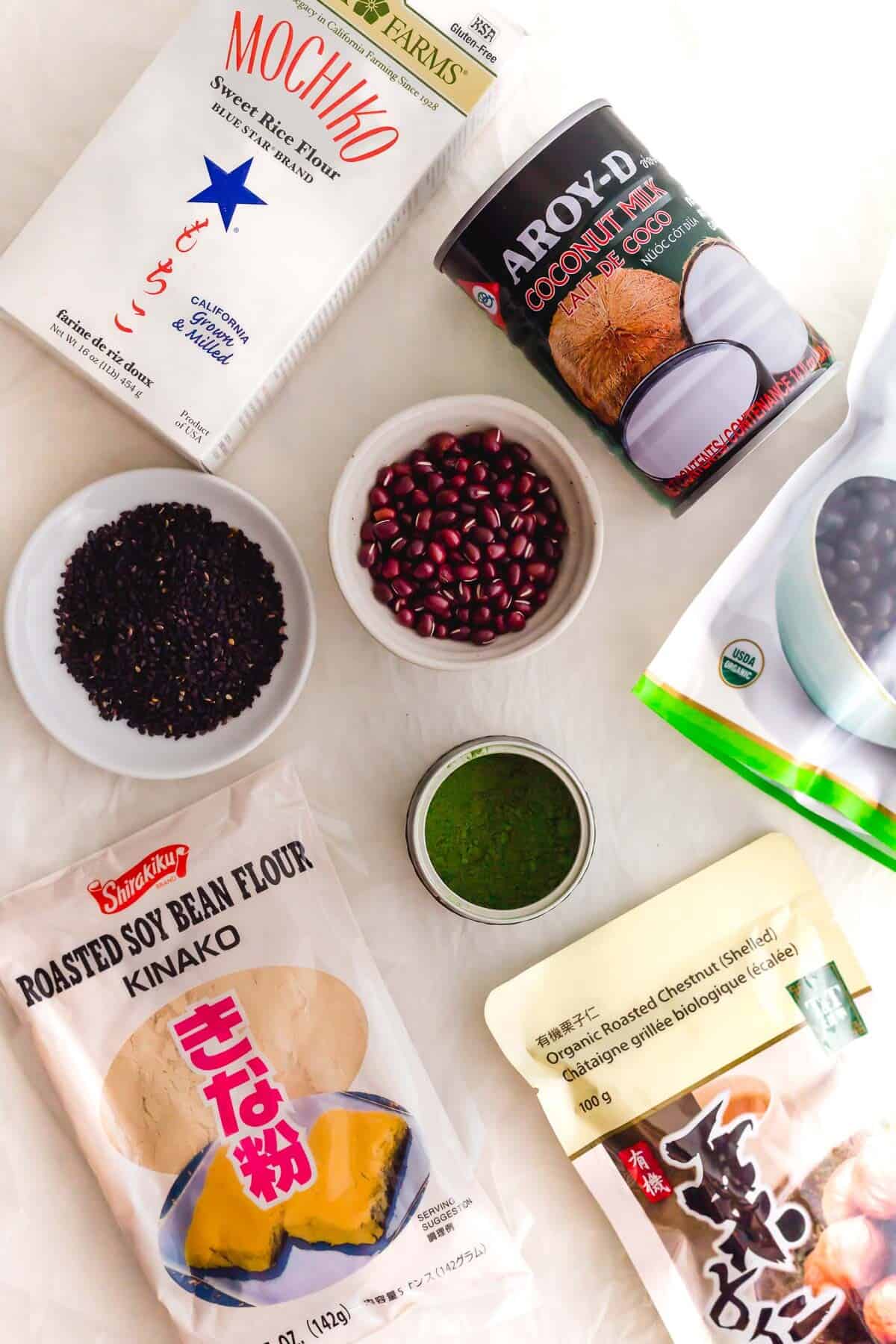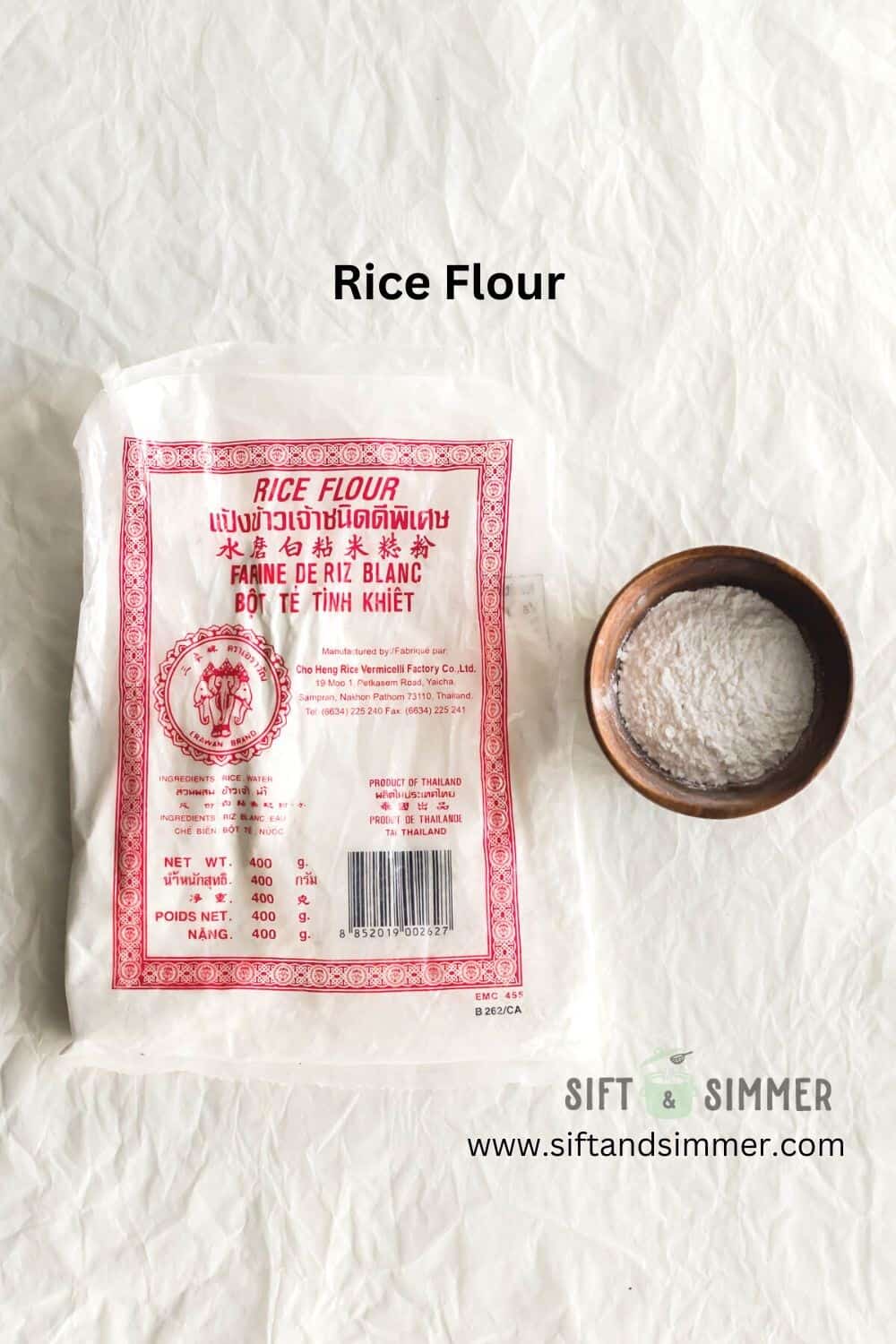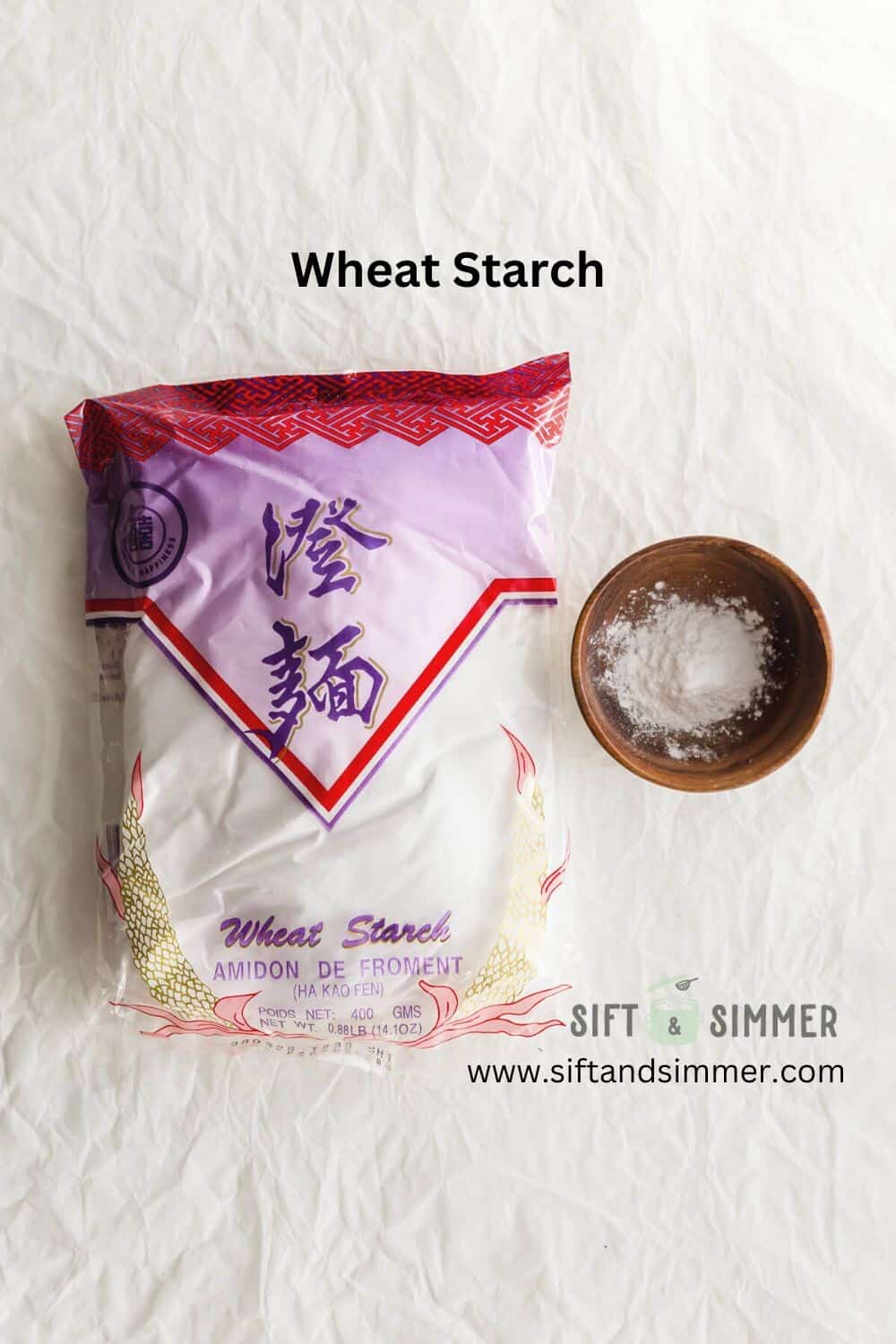Here is a list of Asian pantry ingredients that I use in my recipes.
Most of the ingredients are available at Asian supermarkets or grocery stores.
Some are harder to find, which I've noted.

Adzuki red bean
Also known as azuki red bean, red mung bean, is a red bean, commonly used in East Asia.
Typically packaged as dry red beans.
Used as a boiled and cooked bean, sweetened and mashed into a paste or served in desserts (cendol).
Taste: mild, sweet, nutty flavour
Appearance: maroon-colored small red bean with a white line.
Used in Steamed Red Bean Paste Buns, Chinese Red Bean Soup, Strawberry Red Bean Mochi

Black sesame
Are tiny, flat black seeds originating from Asia. They're similar to its white counterpart.
Can be purchased as whole seeds, or as powder.
Frequently used whole or made into into a paste.
Taste: earthy, nutty flavour
Appearance: small, tiny, black oval seeds
Commonly used as a filling for steamed buns, glutinous rice balls (tang yuan) or mochi.
Used in: Black Sesame Brochi (Brownie Mochi), No Churn Black Sesame Ice Cream, Black Sesame Paste

Chinese sesame paste
Is a rich, smooth brown paste made from toasted, ground hulled sesame seeds.
It is different than Middle Eastern tahini, which is lighter in colour.
Taste: deep, roasted nutty flavour
Used in sauces and dressings, typically over cold sesame noodles.

Coconut milk
Is a white-coloured, opaque liquid extracted from the pulp of mature coconuts.
It is different than coconut water, which is a clear-coloured juice.
Used in many Southeast Asian desserts and dishes.
Available in canned or boxed in supermarkets.
Taste: rich, creamy, sweet, and nutty
Note: I use full-fat (60% fat) canned coconut milk, (theoretically "coconut cream") in my recipes.
Used in: Laksa, Bubur Cha Cha (Malaysian Coconut Milk Dessert), Cendol

Cooked glutinous rice flour (koh fun)
Is a toasted glutinous rice flour used in making mooncakes.
Can be difficult to find in Asian supermarkets.
You may make it at home.
Appearance: lightly beige/tan coloured
Used in Snowskin Mooncakes, Wife Cakes
Durian
Also known as the "King of the Fruits" in Southeast Asia, and is a fruit that can elicit strong opinions.
Appearance: It has a hard spicy exterior shell and yellow soft flesh with large pit.
Usually available frozen as a whole fruit, or pre-packaged, or in freeze-dried form.
Can be quite expensive.
Taste: creamy, sweet, custard-like; can be described as onion-like to others
Used in Durian Cream Mochi, Pandan Durian Cream Roll Cake, Durian Cream Pancakes
Glutinous rice flour/mochiko
Is also known as sweet rice flour. Made from long-grain or short-grain white rice.
Although it has "glutinous" in the name, it does not contain any gluten. Rather, "glutinous" refers to its overall stickiness.
Thai glutinous rice flour (Erawan green and white packaging) is made from long-grain glutinous rice.
Japanese glutinous rice flour (Mochiko) is made from short-grain glutinous rice and has a more chewy, less sticky texture.
For the most part, they can be used interchangably.
Appearance: white, powdery
Adds a soft, chewy texture to foods.
Used in Chinese Fried Sesame Balls (Jian Dui), Mango Cream Mochi, Ham Sui Gok (Fried Glutinous Rice Dumplings)

Hojicha
Is a Japanese roasted green tea, with a mild, smoky, caramel-like flavour.
Available as loose leaf or in powder form, similar to matcha.
Appearance: reddish-brown, powder
Taste: smoky, caramel, nutty flavour
Used in: Hojicha Chestnut Flower Buns, Pumpkin Hojicha Cheesecake, Hojicha Black Sesame Oat Latte

Kinako (soybean powder)
Is made from roasted soybean, and ground into a fine powder.
Also known as injeolmi powder in Korean.
Appearance: golden/tan powder
Has a dry, nutty flavour.
Used to dust rice cakes, mochi, and buns.

Lotus Leaf
Usually dried, very fragile large green leaf.
Larger than bamboo leaf.
Can be difficult to find in Asian grocery stores.
Appearance: large, green with lots of veins
Imparts an earthy, tea-like flavor and aroma to foods, especially rice.
Used in Lo Mai Gai (Sticky Glutinous Rice in lotus leaf).

Lychee
Also known as litchi, is a tropical juicy fruit originating from Southern China.
Appearance: It has a white flesh and thin, rough, reddish skin with a small brown pit.
Similar but different to longan, which has smooth brown skin.
Has a floral fragrance and sweet taste.
Typically in season from May until September.
Used in desserts, or eaten on its own.
Used in Rose Lychee Raspberry Cupcakes, Sparkling Strawberry Lychee Jasmine Tea, Homemade Lychee Syrup

Maltose
Also known as malt sugar, is a natural sugar made from malt and grain (such as corn, wheat, or rice).
It tastes sweet, but is not as sweet as sugar.
Used in making candies, as well as glazing meats, such as char siu roasted BBQ pork or roasted duck.
Appearance: golden in colour, very thick and viscous
Used in Crunchy Sesame Peanut Candy, Chinese Red Date Candy, Homemade Char Siu (Roasted BBQ Pork)

Matcha
Is a Japanese green tea powder, with an earthy, grassy flavour.
Used in tea, baking and sweets.
Appearance: green powder
Used in Classic Matcha Chiffon Cake, Matcha Latte, Matcha Shokupan (Japanese Milk Bread)

Miso
Is a Japanese seasoning made from fermented soybeans, salt and a grain (rice or barley). It has a predominantly salty flavor, which adds umami to various dishes.
Comes in various varieties including white miso, red miso and a blend of the two, known as awase miso.
Appearance: tan/red paste
Used in Miso Soup, Miso Mushroom Focaccia

Mung bean flour
Is a flour made from green mung beans, also known as moong flour.
The insides of the green mung beans are yellow.
Appearance: green/yellow powder
Used in Chinese Macau-Style Almond Mung Bean Cookies

Mung bean starch
Also known as green been amylase, which is different than mung bean flour.
It has a white colour and is the starch extracted from the mung beans.
Appearance: white powder
Used in Cendol
Pandan
Also known as screwpine leaf, and is a tropical cultivated plant predominantly found in Southeast Asia.
It has a vanilla-like scent and is used to flavour both sweet and savoury dishes.
Can be found frozen or fresh.
Appearance: long, green blade-like leaf
Taste: sweet, vanilla-like
Used in Pandan Simple Syrup, Kaya Pandan Coconut Jam, Pandan Mochi Waffles
Potato starch
Similar to cornstarch and tapioca starch, used for coatings, and making things crispier.
Appearance: white, powder
Used in Matcha Waffles, Vietnamese Pork Roll (Cha Lua), Bo Vien (Vietnamese Beef Balls)
Rice flour
Is a flour made from ground/milled rice.
Typically, it refers to flour made from white non-glutinous rice.
Used to add a lighter texture to baked goods, and can act as a thickener.
Appearance: white, powdery
Used in Korean-Style Hot Dogs, Rice Noodle Rolls (Cheong Fun), Black Sesame Paste

Sakura
Also known as Japanese cherry blossoms, are an edible flower from ornamental cherry trees.
Usually pickled and salted, served in wagashi (Japanese confectionary).
Appearance: pink/white florals, sometimes with stems attached
Taste: sweet, fruity rose-like flavor, a little earthy and bitter
Used in Sakura Cherry Blossom Panna Cotta Jelly, Sakura Strawberry Latte, Sakura Lychee Fizz

Soybean (dried)
Need to be rinsed and soaked first before using.
Appearance: small, round, beige spheres
Used primarily to make soybean milk.

Tapioca starch
Also known as tapioca flour, a white starch from the cassava plant.
Used in both cooking and baking.
Can be used as a thickening agent, and adds a light and chewy texture to baked goods.
Appearance: white powder
Used in Korean Matcha Mochi Bread, Homemade Tapioca Pearls (Boba) for Bubble Tea, Prawn Crackers/Shrimp Chips (Keropok)
Tapioca pearls/boba
Made from tapioca starch and water, uncooked, dry tapioca pearls are hard, round spheres.
Once cooked, they transform into chewy round spheres that are commonly used in desserts.
Small white pearls used in sweet desserts such as Mango Sago Pudding; larger ones are often found in bubble tea.
Appearance: round spheres, white or brown, varying sizes
Taste: chewy, soft
Used in HK Milk Tea Bubble Tea

Taro
Is a starchy root vegetable used in sweet and savoury dishes.
It is different than ube.
Appearance: brown exterior, light beige-colored flesh with purple flecks.
Taste: has a vanilla-like, sweet, earthy and nutty flavour.
Commonly used in dishes such as taro dumplings (wu gok), taro milk bubble tea, savoury taro cake.
Used in Taro Milk Bubble Tea, Steamed Taro Buns, Taro Coconut Cake

Ube
Is a purple yam commonly found in the Philippines, known for its vivid purple hue.
It is different than Okinawan purple sweet potato and may be difficult to find fresh ube in North America.
However, you may be able to find frozen ube in Asian supermarkets.
Alternatives: you can use ube extract, which is a vibrant purple-hued extract with a vanilla-like flavor, or swap with purple sweet potato.
Most commonly prepared as Ube Halaya Jam, which is a spread made with mashed ube and sweetened condensed milk.
Appearance: bright, deep purple
Taste: sweet, nutty, and vanilla-like
Used in Ube Halaya Jam, Iced Ube Latte (Purple Yam Coffee), Ube Marble Bread
Wheat starch
A white powdery starch from the manufacture of wheat flour.
Adds a smooth texture to foods.
Typically used in making crystal dumplings (fun guo) and shrimp dumplings (har gao).
Appearance: white, smooth powder
Used in Ham Sui Gok (Fried Glutinous Rice Dumplings), Steamed BBQ Pork Buns (Char Siu Bao)

Yuzu
Is a Japanese citrus fruit, similar to an orange and grapefruit.
Yuzu juice is typically used in ponzu, as well as in desserts.
Appearance: orange/yellow in colour; juice is clear in color, slight tinge of yellow
Used in Matcha Yuzu Gin Fizz, Cranberry Yuzu Sauce, Matcha Yuzu Hot Cross Buns

